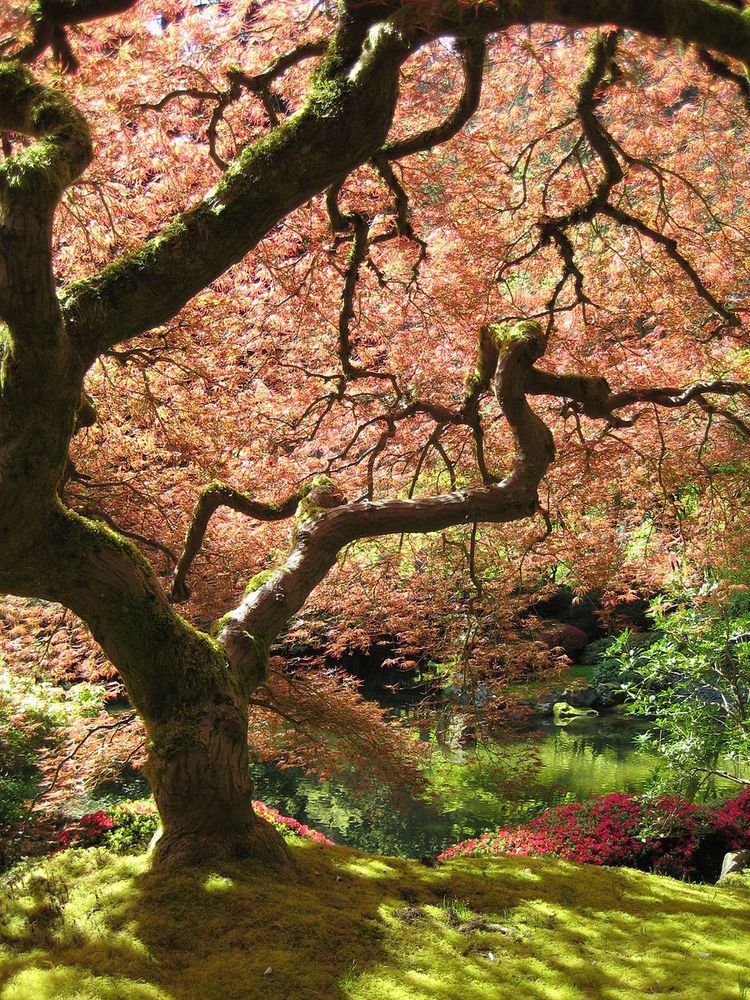Status Open to the public Phone +1 503-223-1321 | Visitors 300,000 Area 2 ha Opened 1967 | |
 | ||
Operated by Japanese Garden Society of Oregon Collections Strolling Pond GardenNatural GardenSand and Stone GardenFlat GardenTea Garden Address 611 SW Kingston Ave, Portland, OR 97205, USA Hours Open today · 10AM–7PMFriday10AM–7PMSaturday10AM–7PMSunday10AM–7PMMonday12–7PMTuesday10AM–7PMWednesday10AM–7PMThursday10AM–7PMSuggest an edit Similar Profiles | ||
Tour the portland japanese garden
The Portland Japanese Garden is a traditional Japanese garden occupying 5.5 acres (22,000 m²), located within Washington Park in the West Hills of Portland, Oregon, United States. It is operated by the Japanese Garden Society of Oregon, a private non-profit corporation, which leased the site from the city in the early 1960s and whose members elect the trustees of the Society. Stephen D. Bloom has been the chief executive officer of the Japanese Garden Society since 2005.
Contents
- Tour the portland japanese garden
- Portland japanese garden 20141025 1080p hd
- Features
- History and awards
- Logistics
- References
Portland japanese garden 20141025 1080p hd
Features
The 5.5 acre Portland Japanese Garden is composed of five sub-gardens. As a Japanese garden, the desired effect is to realize a sense of peace, harmony, and tranquility and to experience the feeling of being a part of nature. The garden has five major sub-gardens, each a different degree of formality:
Three of the essential elements used to create the garden are stone, the "bones" of the landscape; water, the life-giving force; and plants, the tapestry of the four seasons. Japanese garden designers feel that good stone composition is one of the most important elements in creating a well-designed garden. Secondary elements include pagodas, stone lanterns, water basins, arbors, and bridges. Japanese gardens are asymmetrical in design and reflect nature in idealized form. Traditionally, human scale is maintained throughout so that one always feels part of the environment and not overpowered by it.
The Garden Pavilion was built in 1980 in Japanese style by local builders: it has a tiled roof, wooden verandas, and Shōji sliding doors. It is the center of several Japanese cultural festivals, art exhibitions, and other events. The west veranda faces the Flat Garden, and the east veranda overlooks downtown Portland and Mount Hood, which resembles Mount Fuji. Dozens of stone lanterns are present throughout the garden. The lower entrance features a 100-year-old temple gate, a 1976 gift of the Japanese Ancestral Society of Oregon.
History and awards
The garden was designed by Professor Takuma Tono. The garden was dedicated and design began in 1963; the garden opened to the public in 1967. In a study conducted in 2004 by the Journal of Japanese Gardening, it was ranked second out of 300 public Japanese gardens outside Japan for highest quality. The Japanese ambassador to the U.S., Nobuo Matsunaga, said "I believe this garden to be the most authentic Japanese garden, including those in Japan." This is notable because a traditional Japanese garden normally takes hundreds of years to evolve and mature, but the Portland Japanese Garden evolved much more quickly—a fusion of hurried western style and stately eastern expression.
The garden adopted an expansion plan on January 7, 2011. As of August 2014, the plan called for the garden to grow by more than three acres, adding a chabana garden, ticketing pavilion, garden house, tea café, cultural center, and a gift store. Plans for the $33.5 million expansion were finalized in July 2015. Kengo Kuma and Associates will lead the design of 11,000 square feet (1,000 m2) of new areas. Groundbreaking took place in August 2015, with construction projected to be complete by early 2017; the garden was closed for several months between late 2015 and early 2016, reopening in March of that year.
Logistics
The Japanese Garden is close to Washington Park's main entrance, at the top of Park Place, just above and a short walk from the International Rose Test Garden. Parking can be scarce on sunny days, but TriMet line 63 stops nearby, as does the Washington Park Shuttle.
The Portland Japanese Garden is across from the tennis courts. Also, the Washington Park and Zoo Railway has a station by the rose garden. During the summer, it connects to the Oregon Zoo, World Forestry Center, MAX, Portland Children's Museum, Oregon Vietnam Veterans Memorial and Hoyt Arboretum.
After a short ascent up the hillside one reaches the admissions gate. The Japanese Garden provides a shuttle from the parking lot for easier access to the gate. Handicap parking is also available at the top.
Even though located in a public park, there is an admission fee (ranging up to $9.50 per adult as of 2016).
